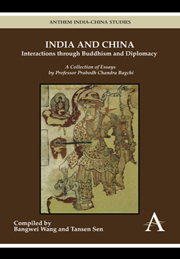 India and China: Interactions through Buddhism and Diplomacy
India and China: Interactions through Buddhism and Diplomacy Book contents
- Frontmatter
- Contents
- Compilers' Note
- Introduction (English and Chinese)
- Part One
- 1 Ancient Chinese Names of India
- 2 The Beginnings of Buddhism in China
- 3 Indian Influence on Chinese Thought
- 4 A Note on the Avadānaśataka and its Chinese Translation
- 5 Bodhisattva-śīla of Śubhākarasiṁha
- 6 A Fragment of the Kāśyapa Saṁhitā in Chinese
- 7 The Chinese Mysticism
- 8 Some Early Buddhist Missionaries of Persia in China
- 9 Some Letters of Hiuan-Tsang and his Indian Friends
- 10 New Lights on the Chinese Inscriptions of Bodhgayā
- 11 A Buddhist Monk of Nālandā amongst the Western Turks
- 12 Political Relations between Bengal and China in the Pathan Period
- 13 Chinese Coins from Tanjore
- 14 Report on a New Hoard of Chinese Coins
- 15 Ki-pin and Kashmir
- 16 Sino-Indian Relations – The Period of the United Empires (618–1100 A.D.)
- Part Two Short Articles
- Part Three Articles in Bengali
- Appendix
- Index
3 - Indian Influence on Chinese Thought
from Part One
Published online by Cambridge University Press: 05 March 2012
- Frontmatter
- Contents
- Compilers' Note
- Introduction (English and Chinese)
- Part One
- 1 Ancient Chinese Names of India
- 2 The Beginnings of Buddhism in China
- 3 Indian Influence on Chinese Thought
- 4 A Note on the Avadānaśataka and its Chinese Translation
- 5 Bodhisattva-śīla of Śubhākarasiṁha
- 6 A Fragment of the Kāśyapa Saṁhitā in Chinese
- 7 The Chinese Mysticism
- 8 Some Early Buddhist Missionaries of Persia in China
- 9 Some Letters of Hiuan-Tsang and his Indian Friends
- 10 New Lights on the Chinese Inscriptions of Bodhgayā
- 11 A Buddhist Monk of Nālandā amongst the Western Turks
- 12 Political Relations between Bengal and China in the Pathan Period
- 13 Chinese Coins from Tanjore
- 14 Report on a New Hoard of Chinese Coins
- 15 Ki-pin and Kashmir
- 16 Sino-Indian Relations – The Period of the United Empires (618–1100 A.D.)
- Part Two Short Articles
- Part Three Articles in Bengali
- Appendix
- Index
Summary
The first contact of China with India goes back to the second century B.C. when certain scientific and cosmological notions infiltrated into China probably through the nomadic agencies of Eastern Turkestan. One of the most renowned Taoists of this period, Prince Lieu-ngan (Huai Nan-tseu), introduced for the first time a cosmology according to which the universe is divided into nine regions spread around a central mountain upon which are arranged the heavenly-worlds. This cosmology is of Indian origin and specially developed in the Buddhist literature.
China received Buddhism from the same nomadic sources, towards the end of the first century B.C. and within a century it was officially recognized as a religion worthy of toleration. Buddhist scholars began coming to China from the end of the first century after Christ and their activities were more and more intensified. But throughout the Han period (65–220), although a number of scholars had come to China, worked among the Chinese and translated a fairly large number of texts into Chinese, Buddhism had a hard struggle with the indigenous systems. Confucianism with its traditional prestige in the court and its hold on the nobility looked down on Buddhism as a barbarian religion. The Chinese, like the Greeks, looked upon all foreigners as barbarians and Indians were no exception to the rule. In the Han period attempts were made to transform Confucianism into a religion but its religious character was much less developed than Buddhism.
- Type
- Chapter
- Information
- India and China: Interactions through Buddhism and DiplomacyA Collection of Essays by Professor Prabodh Chandra Bagchi, pp. 25 - 42Publisher: Anthem PressPrint publication year: 2011


